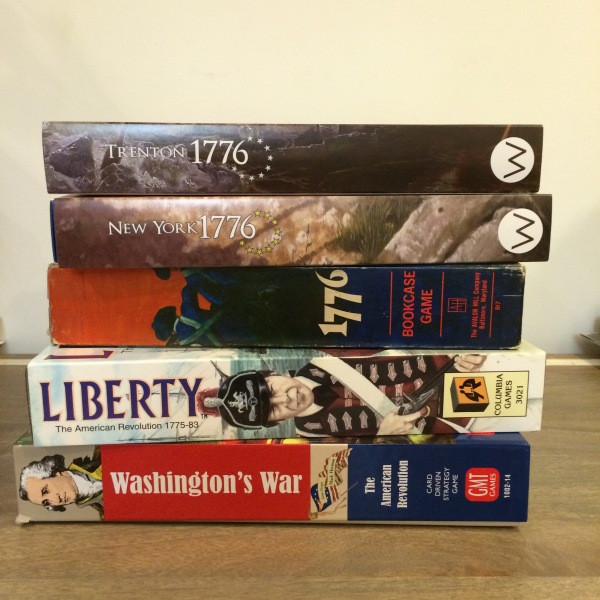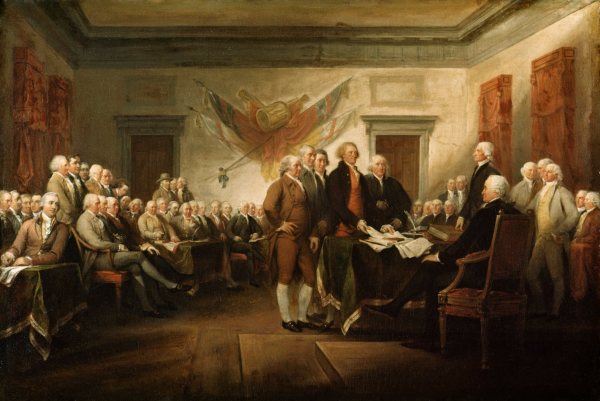
I’ve been continuing to scratch a serious American War of Independence itch for months now. Last summer I took a first pass at some of my favorite games of the period in Boardgames of the American Revolution, Part I. Since then, gamers have also been blessed with the release of Liberty Or Death: The American Insurrection, and it has fast become one of my all-time favorites among all the games I’ve played.
Away from the tabletop, I’ve been swept up in the fervor of Hamilton: The Musical and have been fortunate to catch the show twice on its record-setting Broadway run here in NYC. I’ve also recently revisited 1776 from 1969 and it’s 1972 movie adaptation. As luck would have it a new production will run for one weekend in early April at City Center here in the city, and yes, I’ve already got my tickets. A side note of Broadway trivia is that 1776‘s Tony Award-winning Broadway debut was in the same theater where Hamilton is currently running, and it too seems destined to sweep the awards in June.
But, back to games.
In this Part II, I take a look at more games of the Revolution I’ve managed to acquire and/or play in the past six months. Like the last time, this is not meant to be a comprehensive list. Despite my best efforts there are a lot more games I have yet to touch. What this round presents is again a variety in scope, mechanics and time commitment for gaming the Revolution.
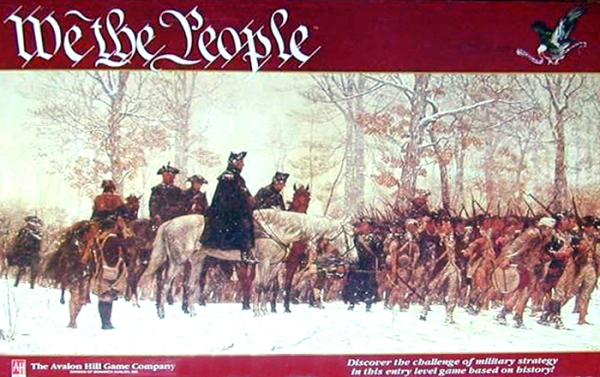
We The People (Avalon Hill)
Avalon Hill’s We The People from 1994 is a landmark in the history of modern wargaming. In taking on the well-worn American Revolution, designer Mark Herman created a number of innovations which have provided the basis for some of the most successful games of the past two decades.
Breaking from the standard hex maps of most prior wargames, WTP’s playing board of the British colonies of North America is abstracted into a series of connected key politically important locations like Long Island, Boston, Fort Niagara and Charleston. While battles play a part in controlling these areas, it is the shifts in political control that are tracked and lead to victory.
Combat in WTP was also stripped down in a few ways. Basic troop units mark the size of forces, but their quality is modified through the presence of leaders. When forces choose to clash in the game, battle cards are used to resolve various battlefield actions steeped in the terminology and effects of 18th-century warfare.
Lastly, the newly-introduced card driven game (CDG) mechanic propel the game’s action through the play of cards, rather than the more traditional roll of dice. With each hand of cards, players have the option of using them to play historically significant events which have varying results for each side of the conflict. Long term planning and success within the game often comes down to having the right cards at the right time.
An old copy of WTP sits on a shelf of club games at Metropolitan Wargamers in Brooklyn, NY, and I recently blew the dust off it for a play. Despite its status at the time of release, I honestly don’t find myself getting this one on the table very often. That said, I feel this game’s presence in so many games I play on a regular basis, and so its true game-changing effects on the hobby reverberate to this day.
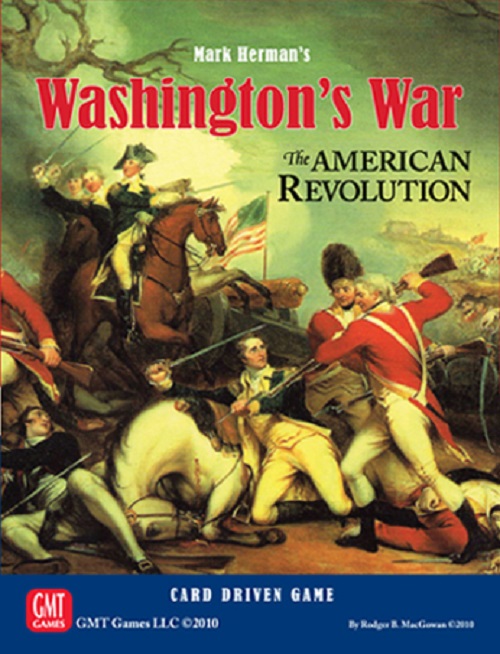
Washington’s War (GMT Games)
Building on the success of WTP, Herman revisited his game of the Revolution in 2010 with Washington’s War from GMT Games. Players familiar with WTP found much similarity with Herman’s original depiction of the period but with a few significant changes.

A recent game of Washington’s War by GMT Games
The CDG mechanic was tweaked to allow for more flexible use of cards and the ability to ‘buy back’ discarded cards. WW also abandoned the battle cards for a dice-off combat resolution, making combat a quicker and more elegant part of the game. I feel the biggest change was in the more asymmetric representation of how the British and Colonial sides each play. The experienced troops of the King are strong on the coasts with their dominant naval power, and the Americans fair better inland but vie with keeping their militia in the action. Generals remain important to both sides, and the French entry to the war plays out in a way that truly captures the historical impact it had.
All the evolutions from WTP make the more recent game a quicker affair, with WW games running at about 90 minutes as opposed to the two hours or so to play WTP. The upgrades to the design and quality of the board, cards and playing pieces all brought the War of Independence into the 21st-century.
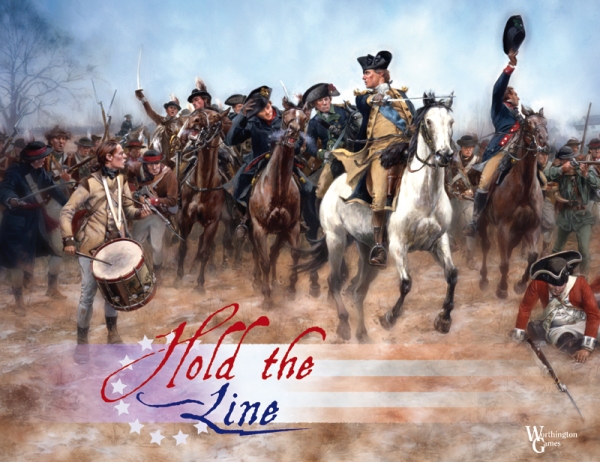
Hold The Line (Worthington Publishing)
In 2008 Worthington Publishing released Hold The Line, a flexible game of the Revolution with a wide appeal from beginners to experienced gamers. Building on the success of their Clash For A Continent: Battles Of the American Revolution and French & Indian War game from three years before, HTL presents a blank hexagonal hardback game board which can be laid out with dozens of included double-sided terrain tiles representing streams, bridges, hills, forests, towns, fences and entrenchments. Terrain has varying effects on line of sight and movement within the game.
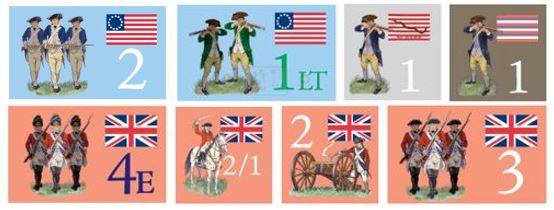
Playing pieces from Hold The Line
Rectangular and square cardboard tiles represent British and Colonial elite, militia, regular and light infantry, dragoons, artillery and generic commanders. The chunky tiles are double-sided to mark losses as game battles unfold. Each turn players roll for random action points which may be spent to move, rally or fire, allowing for each commander to make choices in utilizing their troops. Additionally, the quality of troops and commander presence modify movement and fire ranges. For a simple series of rules, there’s a lot of game in HTL as even the most careful planning by one side over a series of turns can result in a foiled plan if subsequent action point rolls don’t provide enough actions to carry out a planned move or attack.
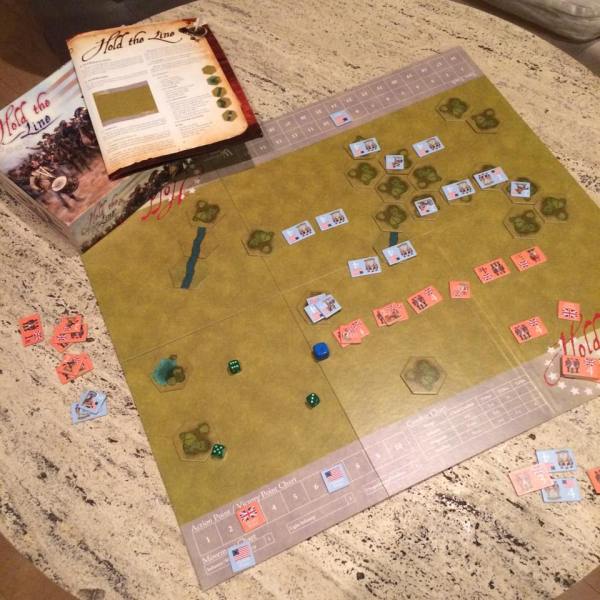
Hold The Line Battle of Monmouth morning scenario
HTL comes with thirteen scenarios for historic battles, each with their own page of historic background, rules and guide to set up. Additional optional rules allow for specific historic leaders, rally rules and morale modifications.Once you’ve played through the included scenarios, numerous additional battle scenarios can be found online from fans of the game. Within a simple design, flexible scenarios and a short set of rules, it’s easy to see why this currently out of print game is a favorite.

Battles of the American Revolution (GMT Games)
Between 1998 and 2013, GMT Games released a series of standalone games of the Battles of The American Revolution. Designed by Mark Miklos, each is a more traditional hex and counter game running three to six hours to play. For those looking to dig into eight key engagements of the War of Independence, the games offer nuances to reflect the historic events and personalities which shaped each battle wrapped in a beautiful modern design.

In late 2015 GMT announced the re-release of the first three games in the series — Saratoga, Brandywine and Guilford — as a tri-pack available through their P500 pre-order program. Since I have never played any of the games from the series, I jumped at the chance to get in on the deal of $45 for three games. The games will get upgrades to mounted maps and a unified rulebook, and additional expansions and tweaks to components a offered in reprints over the years will also be included.
The Revolution Continues…
Having spent the better part of 12 months playing through new and old games of the American Revolution, I find myself definitely leaning toward the more modern games. In order of personal preference, here’s my Top 10:
- Liberty Or Death: The American Insurrection (GMT Games)
- 1775: Rebellion (Academy Games)
- Washington’s War (GMT Games)
- Liberty: The American Revolution 1775-83 (Columbia Games)
- Hold The Line (Worthington Publishing)
- We The People (Avalon Hill)
- New York 1776 (Worthington Publishing)
- Trenton 1776 (Worthington Publishing)
- The American Revolution 1775-1783 (SPI)
- 1776 (Avalon Hill)
The main factors in consideration of the above for me are look, mechanic and importantly, time commitment. Some of the older games from SPI and Avalon Hill just require too much time for me at this stage in my life, and getting a quick game in with my fellow club members or my kids is a big determinant on what gets to the table these days.
What this two-part exercise has done for me is expose how such a diverse gaming experience can be pulled out of one signature conflict with a mix of maps, cardboard and cards. Playing through a span of forty years of American Revolution games, I can only wonder where some designer takes things next. Having gamed my way through the War of Independence, I’ve been spurred on to take a step backward in time to the French and Indian War and see what is revealed on the table next.





